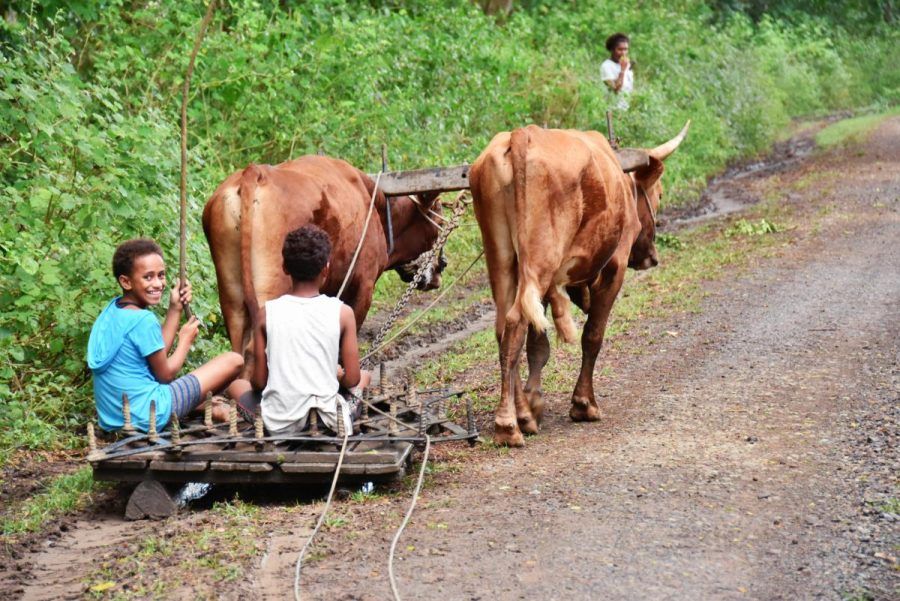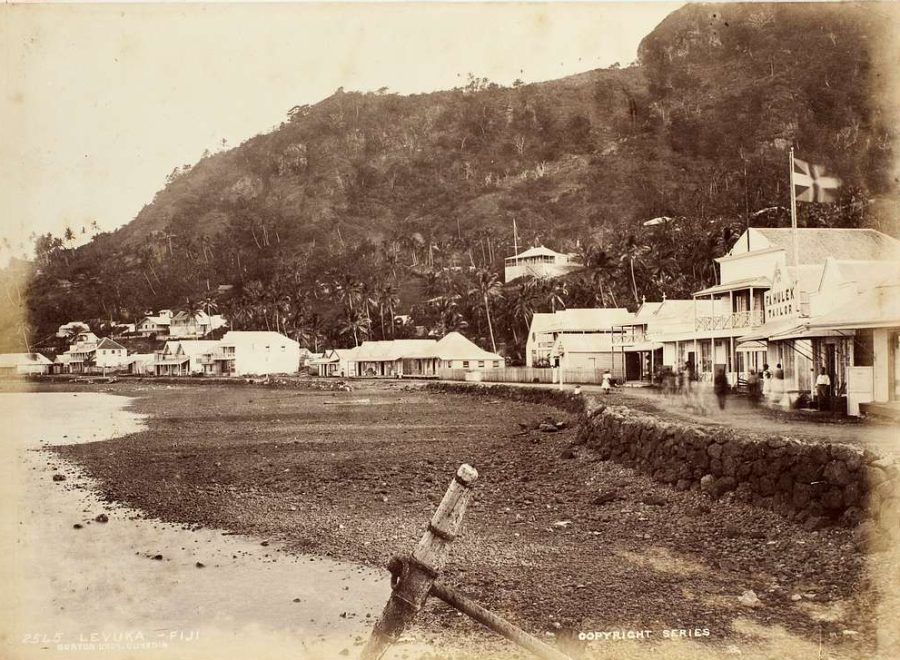The Rules for Visiting a Fijian Village
One of the many amazing things about the islands of Fiji is that the Fijian culture is extremely accessible. There are many opportunities for visitors to see Fijians living and breathing their authentic way of life as they have done for centuries. Sure, there are a few elaborate shows here and there, but when you visit or stay in a Fijian village, you know you are getting the real deal. At first, it can be a bit of a culture shock. People are living off the bare minimum in humble bures they’ve built themselves. But it’s by no means a depressing experience. Fijians are generally happy and are extremely welcoming when inviting visitors into their village. It’s an uplifting experience where you’re bound to learn a great deal, not to mention reflect on what’s important in your own life. Regardless, Fijians have their own distinct culture and set of customs, so it’s vital to know the Fiji village etiquette and what to do when visiting a Fijian village.
It’s important to note that indigenous Fijians are not the only culture in Fiji. Indo-Fijians also make up a significant part of the population, so you may also want to learn some Indo-Fijian customs and traditions. We also go through some Indo-Fijian etiquette towards the end of this guide.
How to Visit a Fijian Village
How can you visit a Fijian village? Typically, you need to be invited to a village, which, in most cases, is either on a village visiting tour or through a homestay. Take a look at 10 Authentic Village Stays in Fiji, as well as the 10 Best Village Tours in Fiji. In some cases, you may enter a village for a tourist attraction. Ask the first person you see how to get to the tourist attraction or for a guide. Of course, always assume you need to pay, so have cash with you.
Before we finally dive into this Fijian customs guide, be sure to bookmark The Guide to the Fiji Culture for Travellers.
Table of Contents
5 Quick Etiquette Tips for Visiting a Fijian Village
We’ll go into much more detail on these rules of etiquette below, but if you’re only going to remember five things, think of these:
- Cover your legs below the knee – the best thing to wear is a sarong.
- Don’t touch people’s heads.
- Bring yaqona root or powder (root is better) as a sevusevu (gift).
- When sitting on the floor, sit cross-legged.
- In the kava ceremony, always accept the first bilo (coconut) of kava.
Want to learn more about how to visit a Fijian village? Check out How to Have a Real Fiji Cultural Experience.
 © FijiPocketGuide.com
© FijiPocketGuide.comWhat to Wear to a Fiji Village
What you need to bear in mind when staying or visiting a Fijian village is to dress conservatively at all times. This is expected of both men and women, but more so by women.
Wear a Sarong (Sulu)
Both men and women should cover their knees. The most acceptable item of clothing for this is a sarong (otherwise known as a sulu in Fijian). It’s best to have this prepared before going to a Fijian village. However, some Fijian village tours or homestay hosts will have spare sarongs to let you borrow.
Cover Your Shoulders
While fewer and fewer villages care about men and women covering their shoulders, others still prefer the shoulders to be covered. Enter a village with your shoulders covered, but if you are staying overnight or longer, ask before uncovering your shoulders.
Dress Smarter on Sundays
Sundays are special days for Christians, of which the majority of the indigenous population are, so try to wear smarter clothes on a Sunday as a sign of respect.
Don’t Wear a Hat or Sunglasses
It is seen as a sign of disrespect to the chief to wear a hat in the village. Wearing sunglasses on your head is disrespectful, too, so tuck them into your shirt or in your bag when taking off your sunglasses.
Swimwear in Fiji
An important rule for wearing swimwear in Fiji is that swimwear should stay at the beach or your resort. You should definitely not walk around any village in your swimwear. Be sure to cover up any swimwear or take the time to change after visiting the beach. Needless to say, being nude at the beach (or anywhere in public) is also not acceptable in Fiji.
For more tips on what to wear, take a look at What to Wear in Fiji: Clothes Packing List.
 © FijiPocketGuide.com
© FijiPocketGuide.comBring a Sevusevu (Introductory Gift)
A long-standing tradition that is still important to partake in, even for international visitors, is presenting a sevusevu to the village chief.
Presenting Yaqona as Sevusevu and How Much Yaqona to Bring
Sevusevu is a gift, and the most acceptable form of sevusevu is yaqona, otherwise known as kava. This is because yaqona is deeply woven into the fabric of Fijian culture and is becoming increasingly more expensive for villagers to buy. Yaqona can be bought in town markets as a root or as a waqa powder. If you have a choice, yaqona in its root form is the most acceptable sevusevu, as villagers can extract more from the drink compared to powder.
Roots are usually presold in individually wrapped bundles and one bundle is enough per village. For powder, about 500 g-1 kg (1.1-2.2 lbs) of yaqona is an acceptable amount to bring. Think of it as the Fiji way of bringing a case of beer or wine to someone’s house when you visit.
Tip: Don’t assume you can buy yaqona at the village or the island you are visiting. Always come prepared.
Other Gifts to Bring to a Fijian Village
Although yaqona is the minimum you would be expected to bring to a village, if you can’t get some yaqona or you want to give the village children something, then gifts for the village children are very well received.
Stationary, like crayons, exercise books and paper, are usually very useful and fun for children, as well as sports equipment like rugby balls. Try to avoid bringing candy, as one, some village children don’t have good access to a dentist, and two, many villages don’t have environmentally friendly ways of disposing of rubbish like candy wrappers.
Who to Give the Sevusevu to
Traditionally, the visitor would give the gift to the turanga ni koro (the village headman), but with most tourists visiting a village with a guide or as part of a homestay, it’s best to ask your guide or homestay host. They will usually present the gift on your behalf during the kava ceremony. (See below for more on the kava ceremony).
 © FijiPocketGuide.com
© FijiPocketGuide.comThe Kava Ceremony
When a new visitor arrives in a Fijian village, a kava ceremony is performed to officially recognise your visit to the village. This may happen soon after you arrive if you are an expected guest, or in the evening when it is more convenient for other villages to attend.
During the kava ceremony, the chief will give a speech, and your guide or host will present your sevusevu to the chief. (Or if it is yaqona root, it will be given to some villagers first to prepare into a powder to make kava). Your host/guide will say a few ceremonial words on your behalf, and then you will be offered a bilo (coconut shell) of kava to drink. Before taking the bilo, clap your hands once and say, “Bula!” before taking a few big gulps to finish the drink. It is expected that you accept the first drink, but accepting more to drink after that is up to you.
After the initial ceremony, you’ll sit around the tanoa (kava bowl) and socialise with the villagers.
Having trouble keeping up with the Fijian words? Get practising with the 10 Fijian Words You Need to Know When Visiting Fiji.
 © FijiPocketGuide.com
© FijiPocketGuide.comOther Etiquette Rules for Staying in a Fijian Village
Some other things to keep in mind include:
- Don’t touch anyone’s head – it’s considered disrespectful.
- When sitting down on the floor (which will happen often), cross your legs so as not to expose the bottom of your feet.
- Speak softly – overly expressive or raised voices might be interpreted as anger.
- Most Fijians will want to be accommodating when it comes to taking photos, but it’s always better to ask before taking photos of them or their home.
- Take your shoes off before going indoors, whether it’s a home, community hall or church.
- If staying in a village, have some cash with you to pay your way for food or activities.
- If eating with a Fijian family, it’s likely that you will all sit cross-legged on the floor. Wait until everyone is sat down and the head of the house says grace (masu) before you start eating.
- Sometimes, food might be prepared for you as a guest and you will be expected to eat first. Then, the family will have whatever is left. With that in mind, if you have been given big portions, don’t try to eat as much as you can. Leave some food for the family to eat after you.
- If you are unsure of what you can and can’t do, ask questions!
What sort of meals will you have in a Fijian village? Take a look at 20 Unique Foods in Fiji You Have to Try.
 © FijiPocketGuide.com
© FijiPocketGuide.comEtiquette in the Indo-Fijian Culture
As mentioned, Fiji is also home to a large population of Indo-Fijians, whose history of immigration to the islands you can learn in A Brief History of Fiji. While much of Fijian cultural etiquette applies broadly, there are some specific considerations for interacting with Indo-Fijians in Fiji.
- Indo-Fijians tend to be more punctual than other ethnic groups in Fiji. When meeting Indo-Fijians, it’s best to arrive on time rather than operating on relaxed “Fiji time.”
- Dress modestly, especially when visiting homes or religious sites. Women should cover their shoulders and knees.
- Remove shoes before entering homes.
- Greet people with a handshake and introduce yourself when joining company.
- Many Indo-Fijians practice Hinduism or Islam. Be respectful of religious customs and dietary restrictions.
- For Hindu Indo-Fijians, avoid touching someone’s head, which is considered sacred.
- If invited to a meal, wait for a prayer to be said before eating.
- Accept offerings. It is seen as incredibly disrespectful to refuse offerings. These may come in the form of tea and sweets or even full meals.
- Feasts are usually reserved for religious festivals or marriages among Indo-Fijians.
For more information about the different ethnicities of Fiji, check out Who are the People of Fiji? Ethnicity, Population & More. Plus, learn about the different religions represented in The Guide to the Religions in Fiji.
More About Fijian and Indo-Fijian Customs and Traditions
That’s it for our guide to Fijian and Indo-Fijian etiquette and how to respect Fiji’s customs and traditions. For more advice regarding the local culture, check out the following guides:
- The Guide to the Religions in Fiji
- A Traveller’s Guide to the Fijian Culture
- Who are the People of Fiji?
Finally, for all your other essential travel tips for the islands, head to The Best Fiji Travel Guide and 30 Tips for Travelling in Fiji.
Sources:
The information in this guide has been compiled from our extensive research, travel and experiences across Fiji and the South Pacific, accumulated over more than a decade of numerous visits to each destination. Additional sources for this guide include the following:
- Tourism Fiji (General travel advice - Updated [2025])
- Fiji Immigration (Visa and immigration advice - Updated [2025])
- Fiji Revenue & Customs Service (Customs and visitor taxes - Updated [2025])
- Biosecurity Authority of Fiji (Biosecurity advice - Updated [2025])
- Fiji Meteorological Service (Weather forecast and warnings - Updated [2025])
- Fiji Bureau of Statistics (Statistics and travel data - Updated [2025])
- Ministry of Tourism and Civil Aviation (Tourism statistics - Updated [2025])
- Land Transport Authority (Road safety advice - Updated [2025])
- Safe Travel (New Zealand travel advisory for Fiji - Updated [2025])
- Smart Traveller (Australia travel advisory for Fiji - Updated [2025])
- Travel.State.Gov (U.S. travel advisory for Fiji - Updated [2025])
- SPTO (Pacific tourism advice - Updated [2025])
- Fiji Hotel and Tourism Association (Tourism trade association - Updated [2025])
Our editorial standards: At Fiji Pocket Guide, we uphold strict editorial standards to ensure accurate and quality content.

About The Author
Laura (Lora) S.
This article was reviewed and published by Laura, editor in chief and co-founder of Fiji Pocket Guide. Since arriving solo in the South Pacific over 10 years ago with nothing but a backpack and a background in journalism, her mission has been to show the world how easy (and awesome) it is to explore a paradise such as Fiji. She knows the islands inside-out and loves sharing tips on how best to experience Fiji’s must-dos and hidden gems. Laura is also editor of several other South Pacific travel guides.




![A Traveller's Guide to the Fiji Cultures 🌺 [2025]](https://fijipocketguide.com/wp-content/uploads/2021/12/Cicia-Lau-Village-School-Children-Meke-CREDIT-Fiji-Pocket-Guide--e1729536240232-900x490.jpg)



